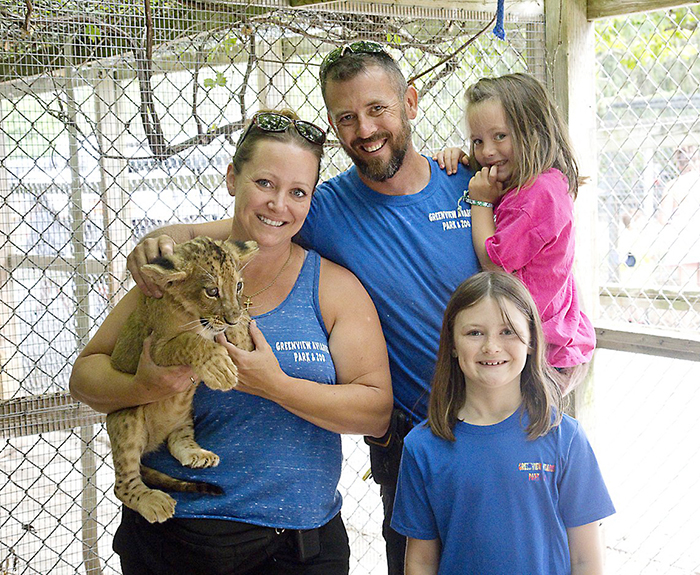
By Bird Bouchard
Local Journalism Initiative Reporter
The Ridgetown Independent
After being listed in the World Animal Protection’s new report into roadside zoos in Ontario, local zoo owners are striving to make Greenview Aviaries a safe, up-to-date home for animals and guests.
In its “Nothing New at the Zoo” report, World Animal Protection is raising concerns about 11 zoos across the province, including Greenview Aviaries in Morpeth. The report states the 11 facilities were selected based on their accessibility, the size and variety of their animal collection and the absence of an official affiliation or recognition from a professional industry association.
Greenview Aviaries, which is home to around 450 animals, including several big cats, was visited on June 29, just 28 days after a change in ownership. Zoo owners and staff were not notified about visits.
As a result of the visit, a complaint was submitted to the Provincial Animal Welfare Services (PAWS) Inspectorate raising concerns over standards of care for captive wildlife and basic standards of care for a variety of animals at the Greenview Aviaries.
The 50-acre property at Greenview Aviaries, which was under different ownership for many years, was recently purchased by the Patten family in Ridgetown.
According to owner Alicia Patten, the family took over the property on June 1. Although the family had some past experience with running their hobby farm, Patten said they are still working on learning the ropes when it comes to caring for exotic animals at the zoo.
In a previous interview, Patten said making improvements, and upgrades to the animals’ enclosures were of major importance to the family and one of the main priorities.
Since taking over as new owners, Patten said the biggest change she and her husband have worked hard to make is the positive change in the animals’ welfare and behaviour.
“The animals have a more healthy and balanced diet. We are already getting compliments, and you can physically see the animals are more calm,” she said.
The accusations from World Animal Protection include fencing of both the lion and tiger enclosures not meeting basic safety standards including, but not limited to:
- Unsafe interactions between the public and primates (ring-tailed lemurs);
- The keeping of primates in undersized enclosures, inhibiting the animals from engaging in their full range of natural behaviour; and
- Standards of care for captive wildlife concerns for ring-tailed lemur, tigers, lions, monkey-enclosures and flamingos.
According to a release from World Animal Protection, the investigation was done to highlight a string of perceived existing violations as well as the organization’s work to push the provincial government to develop a mandatory licensing program for all facilities, businesses and institutions housing native and exotic animals.
“Observations were documented of factors critical for meeting animal health and welfare and visitor health and safety standards as set out in the Ontario Regulation 444/19 Standards of Care and Administrative Requirements,” the report stated.
The report referred to the monkey enclosures as being “grossly undersized, dark, minimalistic enclosures housing crab-eating macaques, black-and-brown lemurs, and ring-tailed lemurs.”
World Animal Protection staff also criticized the flamingo enclosures at the facility.
According to World Animal Protection, Ontario is the last major jurisdiction in Canada that has not licensed or restricted the keeping or use of exotic wild animals in captivity. Instead, the responsibility continues to be on individual municipalities, resulting in a variety of different bylaws across the province.
“The lack of enforcement of what little regulation exists for these facilities is deeply concerning,” said World Animal Protection Campaign Manager Michèle Hamers. “This Wild-West, patchwork system that has been in place for years just doesn’t work, and we know that it needs an overhaul to protect the public and captive wildlife.”
Patten said in late summer that many positive changes were happening, and many positive changes would continue to happen in the future. She said there were also plans to change the enclosing for the big cats.
“It’s bugged me since I was a kid. It’s too small,” she said. “It’s going to look like Pride Rock from Lion King eventually.”
Regarding the report from World Animal Protection, Patten reminds readers of the lengthy to-do list that came with the purchase of the zoo.
“We recently had two animal welfare officers, a zoo inspector and an accredited zoo vet do a very lengthy inspection and assess the property and animals with us,” she said. “At that time, we had drawings/plans, a quote, and a contractor booked to construct new large up-to-date big cat enclosures. We were discouraged at this time to make these enclosures and asked to refocus our time and money where it is needed more; for winter housing.”
Regarding the accusations of not meeting basic safety standards for the big cat enclosures, Patten said the current big cat enclosures had housed these animals for 39 years without issues.
“There are tall fences strung with electric fence and perimeter fencing around that. The issue with the ‘guidelines’ for fencing and structures is the requirements are very vague,” said Patten. “I was unable to get answers on specific guidelines and rules for the size, height, gauge of wire, depth underground, etc. There have been suggestions in place for a few years now for height and overhang, which is what our new structures were going to follow.”
Patten said she was told by inspectors the standards are currently being discussed and will be changed based on the most recent AZA standards in the near future.
“We were advised to await these new guidelines before building, in order to build with the most up-to-date recommendations and standards. And not have to make changes to brand new enclosures if we built them now and requirements change,” she said.
Patten is asking the public to keep in mind they are new zoo owners, and the costs for many changes are not publicly funded.
“Every dollar we have drawn in has been given back to the zoo and will continue to be the case for many years to come,” said Patten.
Patten wishes for everyone to know they are here for the animals’ best interest and will continue to make changes to enclosures on a priority-based agenda when funding is available.
“We will continue to work day and night to make Greenview a safe, up-to-date, beautiful home for the animals we care for and the guests who visit us,” she said.






